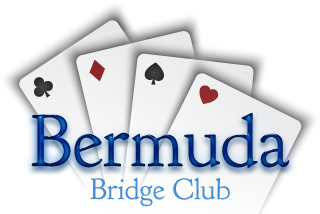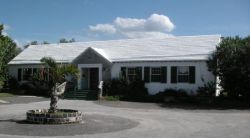The Bermuda Bridge Club was founded in 1932 by Freddie Misick (later to become The Hon F.C. Misick) and he also became the Club's first tournament director. Other officials involved at that time were James E. Pearman (later to become Sir James), Helen Arnell and Jock Arnell who were appointed President, Secretary and Treasurer respectively and Roland Lines who became a Charter Member.
The Club was most fortunate to have Norman Bach come to Bermuda in the late 1940’s as an accountant for the Corporation of Hamilton. Norman had impressive credentials having won the Great Britain Gold Cup in 1938 and, as playing captain, helping Great Britain win the European Championship in 1939. It did not take Norman long to make his mark in Bermuda! After arranging for a team to go the States to play in a challenge match he then organized a challenge match between teams representing the U.S.A., Great Britain and Europe. This match was held at the Castle Harbour Hotel, Bermuda in November 1950 with the American team winning both its matches. The Bermuda Government donated a magnificent Bowl for this event, which became known as the Bermuda Bowl and is still competed for by nations around the world. Norman was also instrumental in forming the local Unit of the American Bridge League (see separate report on the A.C.B.L.). Bridge in Bermuda owes a great deal to the influence of Norman Bach.
Duplicate bridge, rubber bridge and chess were played in the premises above Bluck's on Front Street until April 1958 when the Club moved to Scarborough House (owned by BF&M) on Pitts Bay Road. The Club was greatly indebted to Roland Lines for making this move possible and on very favourable terms (monthly rental $60, 5 year lease and option to renew). The Club grew and prospered at “Scarborough” until early 1974 at which time notice of a substantial rent increase to come into effect in 1975 forced the Club to look at other options including owning their own premises.
When Grant Horneffer, then Club President and also Trimingham’s financial controller, said he was able to negotiate the purchase of a piece of land on Pomander Gate Road, Paget (next to the Aberfeldy Nurseries) owned by Kenneth Trimingham for the sum of $20,000 it was agreed to go ahead with the building of new premises. Quotations were obtained and Colin Roberts was awarded the contract for a price of $40,000 exclusive of air-conditioning, electrical work and painting. A 20 year amortized mortgage for $45,000 (subsequently increased to $50,000) was arranged with the Bank of Bermuda and the balance of funds were raised by interest free debentures in amounts of $250, $500 and $1,000 and donations from sponsors Argus Insurance, Burland Conyers and Mareira, Mundo Gas, N.C.R, Ivy and Graham Rosser, Sea-Land Construction, Southampton Princess Hotel and Cy. Williams. The local Unit of the A.C.B.L also provided substantial financing.
Before work could start on the new building it was discovered that the land had been a swamp and would not support the foundations without piles being driven into the ground. Mr. Trimingham then kindly refunded the Club $5,000 off the purchase price and George Garrison came to the Club’s rescue through his company Sea-Land Construction. He arranged for the piles to be put in place before laying the slabs and foundation and an 11,000 gallon water tank but this was an additional $32,000 to the overall cost. By December 1974 the foundation had been laid and work commenced on the new building. In February 1975 the air conditioning people and electricians were ready to start and Belco were installing their overhead power line to the building. By February 28th the Club was ready to hold its roof wetting ceremony but delay in obtaining a food and liquor licence delayed the official opening until August 28th at which time Sir James Pearman did the honours.
That this project from inception to completion took only some 18months was largely due to the untiring work of Grant Horneffer, ably assisted by Sam Dressler (design and electrics), George Garrison (construction), David Pereira (who drafted the builder’s contract and worked on club plans) and Sir James Pearman (who did all the legal work for the incorporation of the Club and obtained approval for the company to own an acre of land). Joe Wakefield recalls that Colin Roberts died before the building was complete and that it was all hands on deck to finish the work. Cathy Brooks, Diane Cooper, Robin Horneffer, Pat Kett, Bill McKenzie, Colin Millington, Lyn O’Neill, Mike Parker, Audrey Smith and Joe Wakefield were always there to help with painting the club premises and whatever else needed doing (if I’ve missed anyone, my apologies). Mention must also be made of John and Hetty Knowlton, Brownie and Alice Eve, and Grant and Robin Horneffer who took on the unenviable task of landscaping the grounds.
Joe Wakefield says: “It was truly one of the most heartwarming events of my life”. Colin Millington (who succeeded Grant Horneffer as President) said at the A.G.M: “It may be the Bridge Club to you but it is the Sistine Chapel to me”! One more quote from March 1974 - “We are going to build this club house if I have to do it myself” - so said Grant and a plaque in appreciation is installed in the Club.
In the final analysis, the cost of the building (exclusive of furniture and fixtures) was $115,759 (building $48,726, grading and foundation $42,033, land $15,000 and air conditioner $10,000). Having had to vacate “Scarborough” at the end of March, the Club was able to use the English Speaking Union until moving into their new premises.
Within 15 years, the Club was already outgrowing its space and consideration was being given to extending the premises. By April 1995 an agreement had been reached to build an extension to provide additional playing space and a room in which the A.C.B.L could store their equipment. Colin Moran, then President, chaired the steering committee ably assisted by Terry Huntington who became project manager. The A.C.B.L contributed $25,000 towards the cost and a further $77,500 was raised by issuing 7.5% debentures (cheaper than borrowing from the bank at 9.5%!). Once again, Sea-Land Construction had to be employed to sink piles into the ground so building did not get under way until February 1997. By June, the extension had been completed and the official opening was held on July 5th with Dr. David Dyer doing the honours. The new playing space has been named “The Colin Moran Room” in recognition of his work in overseeing the project. Total cost for the extension and fittings came to $197,622 (almost twice the price of the original building!).
The history of the Club is now well documented with photographs of past members who had contributed significantly to the growth and success of the Club, specifically Jack (Jock) and Helen Arnell, Norman and Edith Bach, Dudley Cooper,H. B (Brownie) Eve, Roland Lines, The Hon. F.C.Misick, John Knowlton, Maude Lines and Sir James Pearman. In addition there are many photographs of teams who represented Bermuda in Bermuda Bowl events going back to 1964 and also of the teams representing the U.S.A., Great Britain and Europe in the first official World Team of Four Match (the fore-runner to the Bermuda Bowl) held at the Castle Harbour Hotel in Bermuda in November 1950. Past Club and A.C.B.L Presidents and winners of all Club Championships going back for some 40/50 years are also listed on plaques hung in the two main playing rooms.
The Club continues to flourish with a membership of around 200 and five duplicate games being held each week. Rubber bridge is no longer played at the Club and the Chess Club is now a separate entity with a weekly game played at the Chamber of Commerce premises. Backgammon became very popular at the Club in the 1970’s and 1980’s thanks to Mike Parker but interest waned after he left the island. Smoking was always a contentious issue at the Club but in February 2004 management decreed that the premises would become a non-smoking zone.
On a final note it is interesting to note how fees have increased over the years.
In 1957 membership fees were £5 (single) and £8 per couple. Table money for duplicate bridge games was 3/- (three shillings!).
By 2007 membership fees were $120 per person and table money $8.
In 1964 an initiation fee of £2.10/- was introduced for new members; it is now $75.
(This January 2009 report on the history of the Bermuda Bridge Club has been kindly prepared by Tony Saunders, an active member of the Club over the past 50 years. Tony was on the Management Committee from 1960 to 1975 serving in various roles, mainly as tournament director, as President and also as the Public Relations Officer. He also served on the Governing Board of the A.C.B.L., was President for 5 years, and involved for many years in running the annual Regional bridge tournaments).

